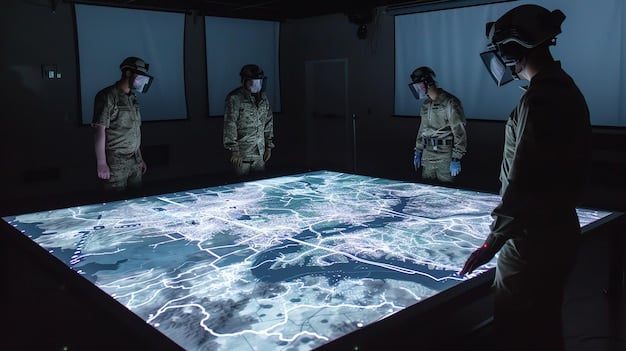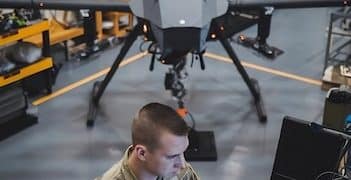Biometrics in Military Security: Access Control & Identification Systems

Biometrics in Military Security: Enhancing Access Control and Identification Systems leverages unique biological traits for secure authentication, improving efficiency and reducing traditional security vulnerabilities.
In today’s increasingly complex security landscape, the military is constantly seeking innovative ways to protect its assets and personnel. Biometrics in Military Security: Enhancing Access Control and Identification Systems offers a powerful solution, utilizing unique biological traits for secure authentication and identification.
The Growing Importance of Biometrics in Military Security
The demand for enhanced security measures within the military has never been greater. Traditional security methods, such as passwords and ID cards, are vulnerable to theft, forgery, and unauthorized access. Biometrics offers a more reliable and secure alternative.
Biometrics, the science of identifying individuals based on their unique biological characteristics, is transforming military security systems. By utilizing technologies like fingerprint scanning, facial recognition, and iris scanning, the military can create more secure and efficient access control and identification systems.
Benefits of Biometric Systems
Biometric systems offer numerous advantages over traditional security measures.
- Enhanced Security: Biometric data is difficult to replicate or steal, making it a more secure form of authentication.
- Improved Efficiency: Biometric scans are quick and easy, reducing delays and streamlining access control processes.
- Reduced Costs: By automating security processes and reducing the need for manual checks, biometrics can lower operational costs.
- Real-time Monitoring: Advanced biometric systems can provide real-time monitoring of personnel movement, enhancing situational awareness and security.

These benefits make biometrics an increasingly attractive option for military applications. As technology advances, biometric systems are becoming more sophisticated and cost-effective, further driving their adoption within the military.
Types of Biometric Technologies Used in the Military
The military utilizes a diverse range of biometric technologies, each with its own strengths and applications. From fingerprint scanning to voice recognition, these technologies provide a robust suite of security measures designed to enhance access control and identification.
Understanding each of these technologies and their specific uses is crucial for comprehending the breadth of biometric applications within the military.
Fingerprint Scanning
Fingerprint scanning is one of the most widely used biometric technologies. It relies on the unique patterns of ridges and valleys on an individual’s fingertips to verify identity.
Advantages include:
- High Accuracy: Fingerprint scanning is highly accurate and reliable, making it suitable for high-security applications.
- Cost-Effective: Fingerprint scanners are relatively inexpensive and easy to integrate into existing systems.
- Ease of Use: Fingerprint scanning is a user-friendly technology that requires minimal training.
Facial Recognition
Facial recognition technology uses algorithms to identify individuals based on their facial features. It can be used for a variety of applications, including access control, surveillance, and identification.
Benefits include:
- Non-Invasive: Facial recognition can be performed from a distance without requiring physical contact.
- Versatile: Facial recognition can be used in a wide range of environments and lighting conditions.
- Scalable: Facial recognition systems can handle large databases of faces, making them suitable for large-scale deployments.
Biometric Access Control in Military Bases
Controlling access to military bases is a critical aspect of security. Biometric access control systems ensure that only authorized personnel can enter sensitive areas, reducing the risk of unauthorized access and potential threats.
By implementing biometric technologies at entry points, the military can significantly enhance the security of its facilities and personnel.
Implementing Biometric Access Control
Implementing biometric access control systems requires careful planning and execution. It involves integrating biometric scanners with existing security infrastructure and establishing protocols for enrollment and verification.
Key steps include:
- Biometric Data Capture: Capturing biometric data from authorized personnel using scanners.
- Data Storage: Storing biometric data securely in a centralized database.
- Verification Process: Verifying the identity of individuals by matching their biometric data against the database.
Case Studies of Successful Implementations
Several military bases have successfully implemented biometric access control systems, demonstrating the effectiveness of these technologies. These case studies provide valuable insights into the benefits and challenges of deploying biometrics in a military environment.
For example, one military base in the US implemented a fingerprint scanning system at all entry points, resulting in a significant reduction in unauthorized access attempts. The system also improved the efficiency of security personnel and streamlined the entry process.
Biometric Identification Systems for Personnel Tracking
In addition to access control, biometric identification systems are used for personnel tracking within military facilities and on the battlefield. These systems provide real-time monitoring of personnel movement, enhancing situational awareness and improving security.
By tracking the location of personnel, the military can respond more effectively to emergencies and ensure the safety of its personnel.
Tracking Personnel in Real-Time
Real-time personnel tracking relies on wearable biometric devices that continuously monitor the location and physiological state of soldiers. These devices transmit data to a central command center, providing a comprehensive view of personnel movement.
Benefits of real-time tracking:
- Enhanced Situational Awareness: Real-time tracking provides commanders with a clear picture of personnel location and status.
- Improved Emergency Response: Real-time tracking enables rapid response to emergencies and the location of injured personnel.
- Increased Accountability: Real-time tracking ensures accountability and prevents unauthorized movement.
Challenges and Considerations for Biometric Implementation
While biometrics offer numerous advantages, there are also challenges and considerations that must be addressed when implementing these technologies in a military context. These challenges include data security, privacy concerns, and the potential for system failures.
Addressing these challenges is crucial for ensuring the successful adoption of biometrics within the military.
Data Security and Privacy
Data security is a major concern when storing and processing biometric data. Military biometric systems must be protected against unauthorized access, theft, and manipulation. Robust security measures, such as encryption and access controls, are essential to safeguard biometric data.
Privacy concerns must also be addressed. Military personnel must be informed about how their biometric data is collected, stored, and used. Clear policies and procedures should be established to protect the privacy rights of individuals.

System Failures and Backup Plans
Biometric systems are not immune to failures. System malfunctions, power outages, and other unforeseen events can disrupt biometric operations. Backup plans and contingency measures are essential to ensure that security is not compromised in the event of a system failure.
These backup plans may include manual override procedures, alternative biometric modalities, or traditional security measures. Regular testing and maintenance of biometric systems are also crucial for preventing failures.
Future Trends in Military Biometrics
The future of military biometrics is marked by continuous innovation and integration of emerging technologies. As technology advances, biometric systems are becoming more sophisticated, accurate, and versatile. The integration of AI and machine learning is expected to further enhance the capabilities of biometric systems.
Understanding these trends is essential for military leaders and security professionals seeking to leverage biometrics to enhance security and operational effectiveness.
AI and Machine Learning Integration
Artificial intelligence (AI) and machine learning (ML) are transforming biometric systems by enabling them to learn and adapt to changing conditions. AI and ML algorithms can be used to improve the accuracy of biometric scans, detect anomalies, and identify potential security threats.
For example, AI-powered facial recognition systems can identify individuals even in challenging lighting conditions or when they are wearing disguises. ML algorithms can also be used to detect fraudulent biometric data and prevent unauthorized access.
Emerging Biometric Technologies
Several emerging biometric technologies are poised to impact military security in the coming years. These technologies include:
- Voice Recognition: Identifying individuals based on their unique voice patterns.
- Gait Analysis: Identifying individuals based on their walking style.
- Vein Recognition: Identifying individuals based on the pattern of veins in their hands or fingers.
- DNA Biometrics: DNA analysis can be used for identification purposes.
| Key Point | Brief Description |
|---|---|
| 🔒 Enhanced Security | Biometrics offer stronger authentication compared to traditional methods. |
| ⏱️ Improved Efficiency | Quick biometric scans streamline access control. |
| 📍 Real-time Tracking | Biometrics enable precise personnel monitoring for enhanced safety. |
| 🛡️ Data Security | Robust measures are crucial to protect sensitive biometric data. |
[Frequently Asked Questions]
▼
The key benefits include enhanced security, improved efficiency in access control, and the capability for real-time personnel tracking, leading to better situational awareness and response.
▼
Common technologies include fingerprint scanning, facial recognition, iris scanning, voice recognition, and, increasingly, more advanced methods like vein recognition and gait analysis.
▼
Biometric access control ensures that only authorized personnel can enter restricted areas, significantly reducing the risk of unauthorized access and potential security breaches.
▼
The main concerns involve data security and privacy, ensuring that sensitive biometric data is protected from unauthorized access and that personnel privacy rights are respected.
▼
Future trends include the integration of AI and machine learning to enhance accuracy and threat detection, as well as the adoption of emerging biometric technologies like voice and gait analysis.
Conclusion
In conclusion, biometrics in military security revolutionize access control and personnel identification. Addressing challenges, integrating AI, and embracing emerging technologies will ensure even greater strides in military security.





